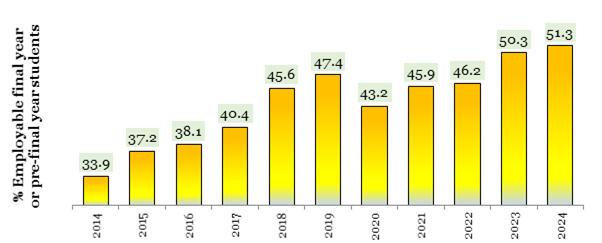Our Terms & Conditions | Our Privacy Policy
Skills for India’s Young Population – OpenGov Asia
India, with a median age of just 28, stands poised to benefit from a significant demographic dividend. However, this potential can only be realised by addressing the existing skill gaps and equipping its young population with the competencies required by a modern, digital landscape.
Image credits: Press Information Bureau
Despite improvements over the past decade- where the percentage of youth with employable skills increased from 34% to 51.3% – the challenge remains substantial. The Indian government has been proactive in implementing various initiatives to enhance skill development and employment opportunities, recognising the crucial role of human capital in driving economic growth.
The Ministry of Skill Development & Entrepreneurship (MSDE) has highlighted the need to revamp the skilling ecosystem. The new Skill India Digital platform, which integrates skilling schemes, educational resources, and government services, marks a significant advance. This platform has facilitated easier access to vocational training, and India’s improved performance in WorldSkills Competitions reflects the success of these initiatives.
The Union Budget for 2024-25 includes a significant initiative to train 2 million youth over five years and upgrade 1,000 Industrial Training Institutes (ITIs). The revised Model Skill Loan Scheme now offers loans up to ₹7.5 lakh (US$9,000) for advanced courses and is expected to benefit 25,000 students annually.
Additionally, financial support for higher education loans up to ₹10 lakh (US$12,000), along with annual interest subventions, will be provided for those not covered by existing schemes.
The National Policy on Skill Development & Entrepreneurship (NPSDE) is a cornerstone of India’s skilling strategy. This policy aims to bridge skill gaps, enhance industry engagement, and establish a robust quality assurance framework. It also focuses on equity by targeting marginalised groups and promoting skill development and entrepreneurship among women. The NPSDE, alongside the National Education Policy (NEP), is poised to address the critical education-employment gap, driving more inclusive economic growth.
- Pradhan Mantri Kaushal Vikas Yojana (PMKVY): Since 2015, PMKVY has trained 1.42 crore individuals, integrating over 1,000 institutions as Skill India Centres. The scheme has introduced 119 new skill courses and significantly increased female participation.
- Craftsmen Training Scheme (CTS): With a network of 14,955 ITIs, CTS is vital for vocational training. Recent improvements include a new grading system to standardise evaluations.
- Jan Shikshan Sansthan (JSS): JSS focuses on skill development for non-literates and low-educated individuals, training 26.36 lakh people with a notable commitment to gender equality.
- National Apprenticeship Promotion Scheme (NAPS): NAPS has engaged 32.38 lakh apprentices, with significant growth in registered establishments and increased female participation. The scheme facilitates stipend reimbursement through Direct Benefit Transfer (DBT).
Entrepreneurship training has been bolstered by institutions like NIESBUD and IIE, which have provided training to over 464 thousand individuals from FY19 to FY24. The Skill India Digital Hub, launched in August 2023, serves as a central platform for accessing skilling resources, including online courses and e-books. The platform has engaged over 60 lakh learners, showcasing its effectiveness in enhancing skill development opportunities.
India’s global skilling initiatives include the establishment of Skill India International Centers (SIIC) and partnerships with countries such as Australia, Germany, and Japan. These efforts aim to enhance international mobility and recognition of Indian qualifications. The Skill Impact Bond and industry collaborations further support skill development and employment, with notable contributions from tech giants like IBM and Microsoft.
India’s approach to skill development demonstrates significant progress in addressing its skill gap. Government schemes such as PMKVY, CTS, and NAPS, along with the Skill India Digital Hub and global partnerships, are paving the way for a more skilled and inclusive workforce. Continued investment and collaboration among the government, industry, and educational institutions will be essential to harnessing India’s demographic dividend and fostering sustainable economic growth.
Images are for reference only.Images and contents gathered automatic from google or 3rd party sources.All rights on the images and contents are with their legal original owners.



Comments are closed.